Analyzing Business Law: Sources, Impact, and Business Organizations
VerifiedAdded on 2023/06/18
|13
|4282
|198
Report
AI Summary
This report provides a comprehensive overview of business law in the United Kingdom, beginning with an explanation of various sources of law, including common law, legislation, European Union law, and the European Convention on Human Rights. It details the government's role in the law-making process and how statutory and common law are applied in courts. The report further explores the potential impact of company law, employment law, and contract law on businesses, highlighting the need for businesses to adapt to legislative changes and manage related paperwork. It examines different types of business organizations, such as sole proprietorships, partnerships, limited liability partnerships, public limited companies, and private limited companies, outlining their legal formations, funding mechanisms, and management structures. Finally, the report touches on resolving disputes and providing legal advice and support, emphasizing the importance of legal compliance for business success. Desklib provides access to similar solved assignments and study resources for students.
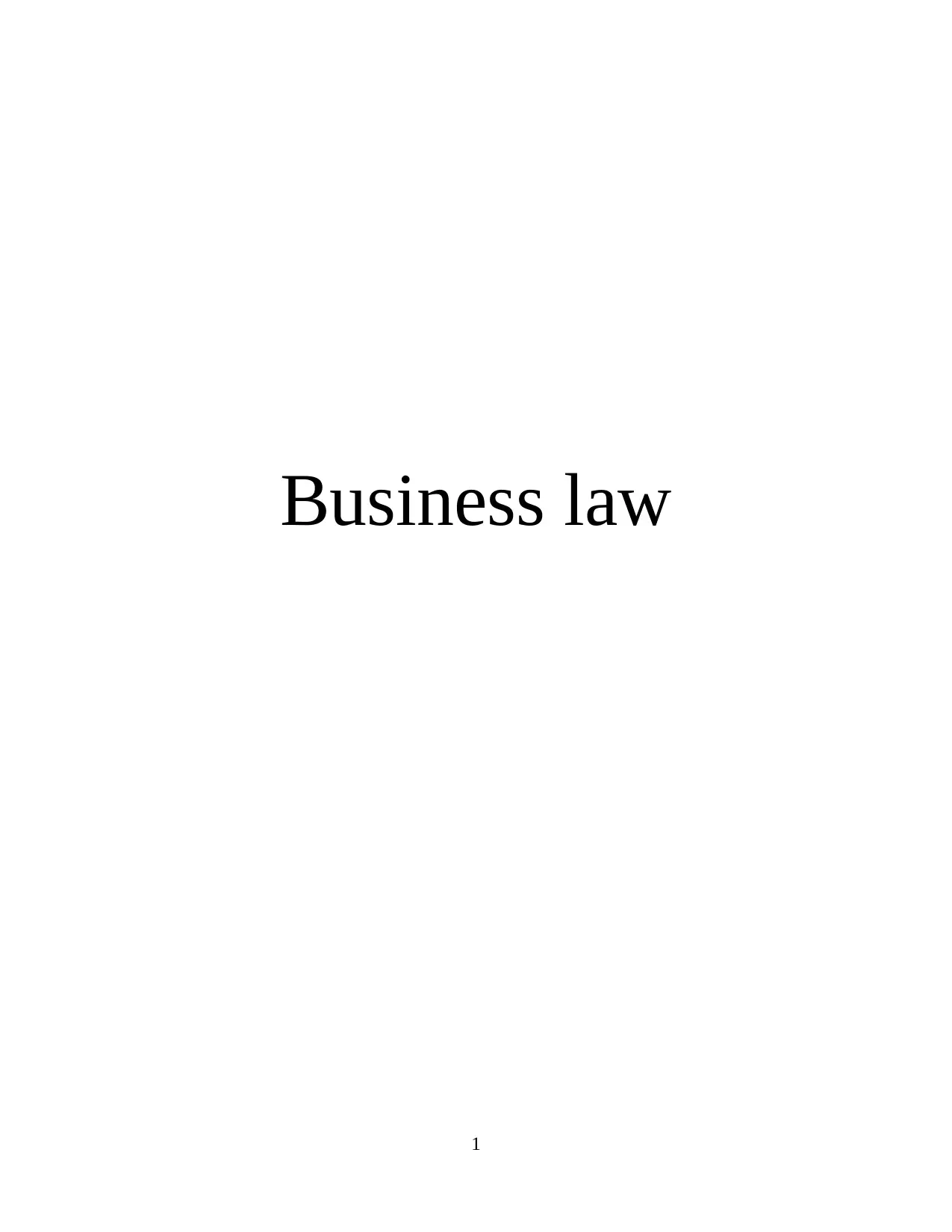
Business law
1
1
Paraphrase This Document
Need a fresh take? Get an instant paraphrase of this document with our AI Paraphraser
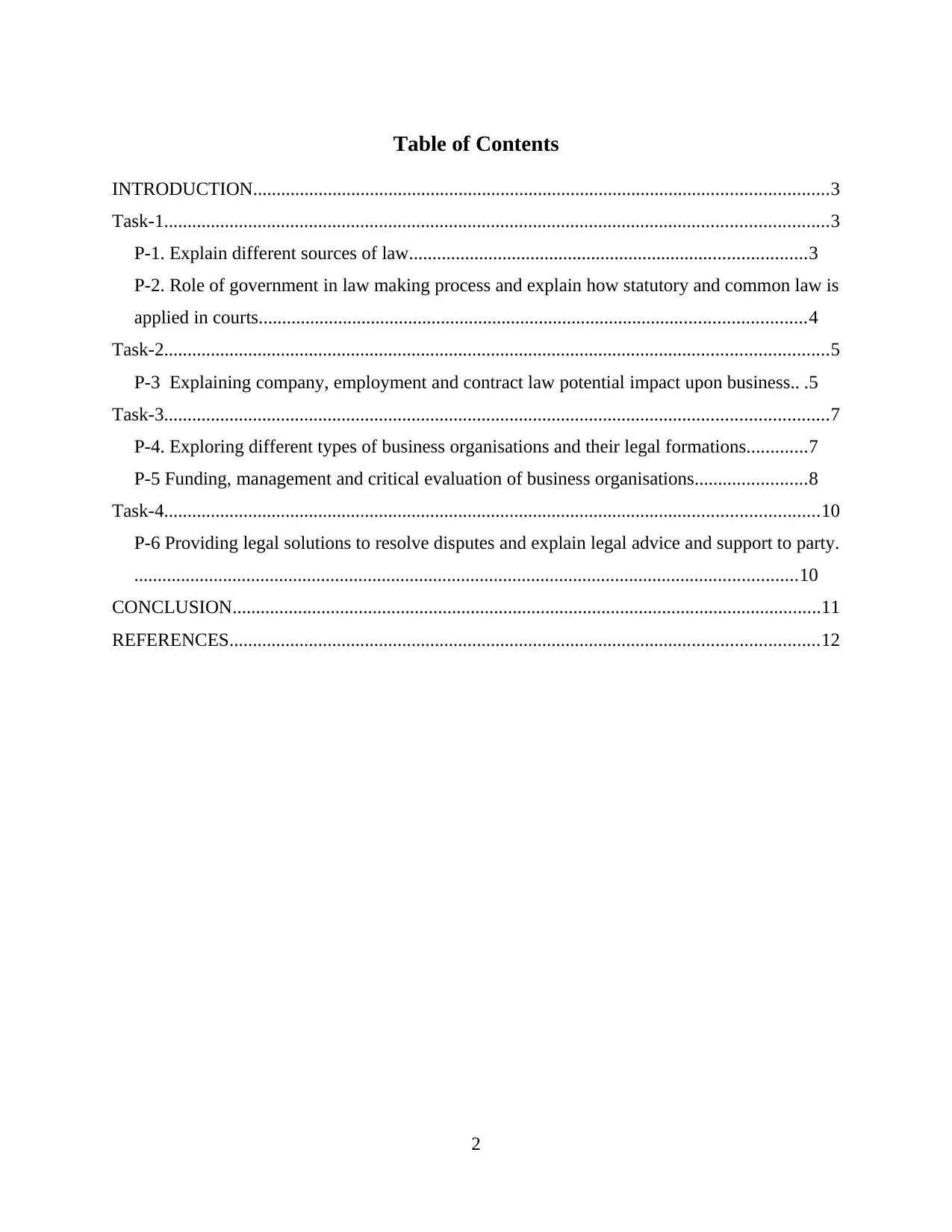
Table of Contents
INTRODUCTION...........................................................................................................................3
Task-1..............................................................................................................................................3
P-1. Explain different sources of law.....................................................................................3
P-2. Role of government in law making process and explain how statutory and common law is
applied in courts.....................................................................................................................4
Task-2..............................................................................................................................................5
P-3 Explaining company, employment and contract law potential impact upon business.. .5
Task-3..............................................................................................................................................7
P-4. Exploring different types of business organisations and their legal formations.............7
P-5 Funding, management and critical evaluation of business organisations........................8
Task-4............................................................................................................................................10
P-6 Providing legal solutions to resolve disputes and explain legal advice and support to party.
..............................................................................................................................................10
CONCLUSION..............................................................................................................................11
REFERENCES..............................................................................................................................12
2
INTRODUCTION...........................................................................................................................3
Task-1..............................................................................................................................................3
P-1. Explain different sources of law.....................................................................................3
P-2. Role of government in law making process and explain how statutory and common law is
applied in courts.....................................................................................................................4
Task-2..............................................................................................................................................5
P-3 Explaining company, employment and contract law potential impact upon business.. .5
Task-3..............................................................................................................................................7
P-4. Exploring different types of business organisations and their legal formations.............7
P-5 Funding, management and critical evaluation of business organisations........................8
Task-4............................................................................................................................................10
P-6 Providing legal solutions to resolve disputes and explain legal advice and support to party.
..............................................................................................................................................10
CONCLUSION..............................................................................................................................11
REFERENCES..............................................................................................................................12
2
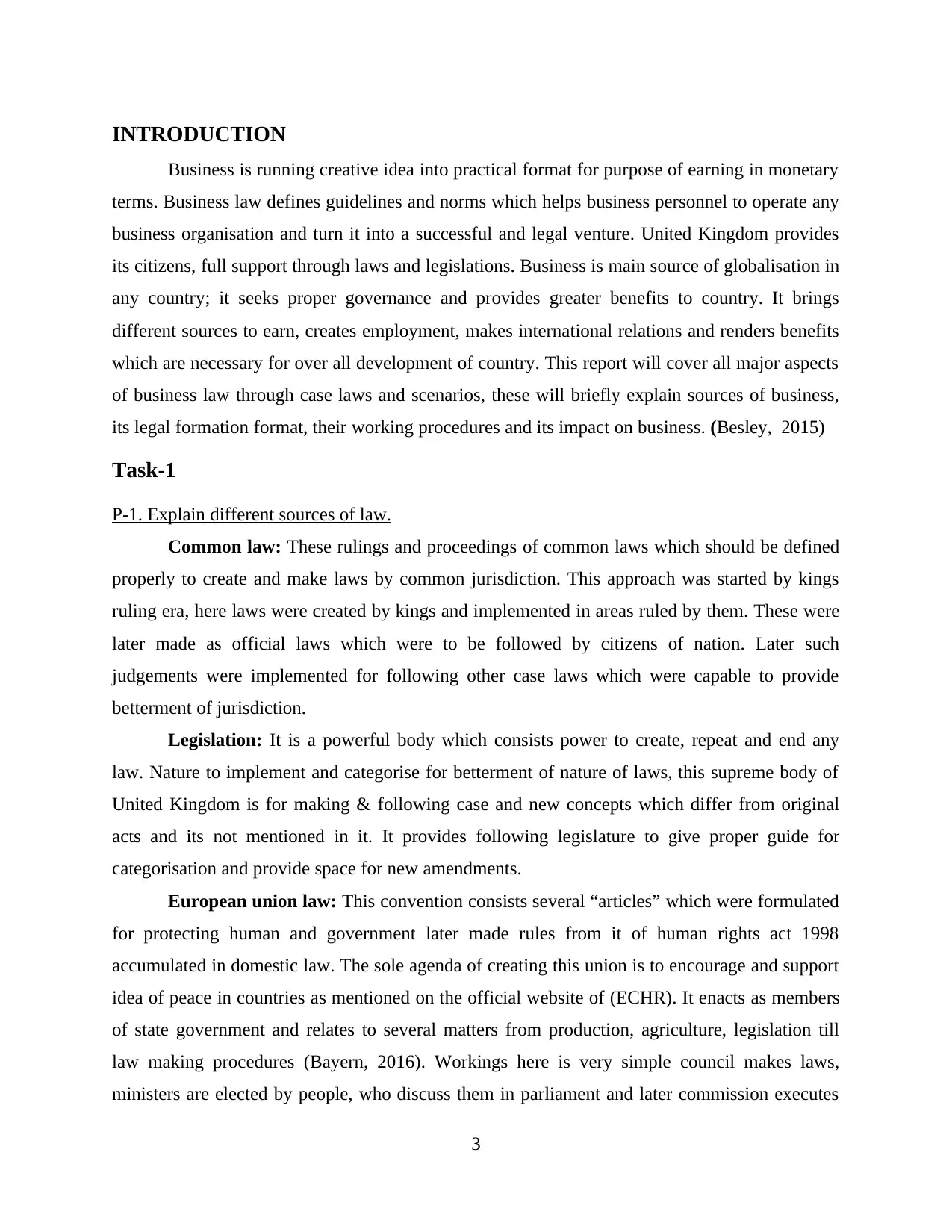
INTRODUCTION
Business is running creative idea into practical format for purpose of earning in monetary
terms. Business law defines guidelines and norms which helps business personnel to operate any
business organisation and turn it into a successful and legal venture. United Kingdom provides
its citizens, full support through laws and legislations. Business is main source of globalisation in
any country; it seeks proper governance and provides greater benefits to country. It brings
different sources to earn, creates employment, makes international relations and renders benefits
which are necessary for over all development of country. This report will cover all major aspects
of business law through case laws and scenarios, these will briefly explain sources of business,
its legal formation format, their working procedures and its impact on business. (Besley, 2015)
Task-1
P-1. Explain different sources of law.
Common law: These rulings and proceedings of common laws which should be defined
properly to create and make laws by common jurisdiction. This approach was started by kings
ruling era, here laws were created by kings and implemented in areas ruled by them. These were
later made as official laws which were to be followed by citizens of nation. Later such
judgements were implemented for following other case laws which were capable to provide
betterment of jurisdiction.
Legislation: It is a powerful body which consists power to create, repeat and end any
law. Nature to implement and categorise for betterment of nature of laws, this supreme body of
United Kingdom is for making & following case and new concepts which differ from original
acts and its not mentioned in it. It provides following legislature to give proper guide for
categorisation and provide space for new amendments.
European union law: This convention consists several “articles” which were formulated
for protecting human and government later made rules from it of human rights act 1998
accumulated in domestic law. The sole agenda of creating this union is to encourage and support
idea of peace in countries as mentioned on the official website of (ECHR). It enacts as members
of state government and relates to several matters from production, agriculture, legislation till
law making procedures (Bayern, 2016). Workings here is very simple council makes laws,
ministers are elected by people, who discuss them in parliament and later commission executes
3
Business is running creative idea into practical format for purpose of earning in monetary
terms. Business law defines guidelines and norms which helps business personnel to operate any
business organisation and turn it into a successful and legal venture. United Kingdom provides
its citizens, full support through laws and legislations. Business is main source of globalisation in
any country; it seeks proper governance and provides greater benefits to country. It brings
different sources to earn, creates employment, makes international relations and renders benefits
which are necessary for over all development of country. This report will cover all major aspects
of business law through case laws and scenarios, these will briefly explain sources of business,
its legal formation format, their working procedures and its impact on business. (Besley, 2015)
Task-1
P-1. Explain different sources of law.
Common law: These rulings and proceedings of common laws which should be defined
properly to create and make laws by common jurisdiction. This approach was started by kings
ruling era, here laws were created by kings and implemented in areas ruled by them. These were
later made as official laws which were to be followed by citizens of nation. Later such
judgements were implemented for following other case laws which were capable to provide
betterment of jurisdiction.
Legislation: It is a powerful body which consists power to create, repeat and end any
law. Nature to implement and categorise for betterment of nature of laws, this supreme body of
United Kingdom is for making & following case and new concepts which differ from original
acts and its not mentioned in it. It provides following legislature to give proper guide for
categorisation and provide space for new amendments.
European union law: This convention consists several “articles” which were formulated
for protecting human and government later made rules from it of human rights act 1998
accumulated in domestic law. The sole agenda of creating this union is to encourage and support
idea of peace in countries as mentioned on the official website of (ECHR). It enacts as members
of state government and relates to several matters from production, agriculture, legislation till
law making procedures (Bayern, 2016). Workings here is very simple council makes laws,
ministers are elected by people, who discuss them in parliament and later commission executes
3
⊘ This is a preview!⊘
Do you want full access?
Subscribe today to unlock all pages.

Trusted by 1+ million students worldwide
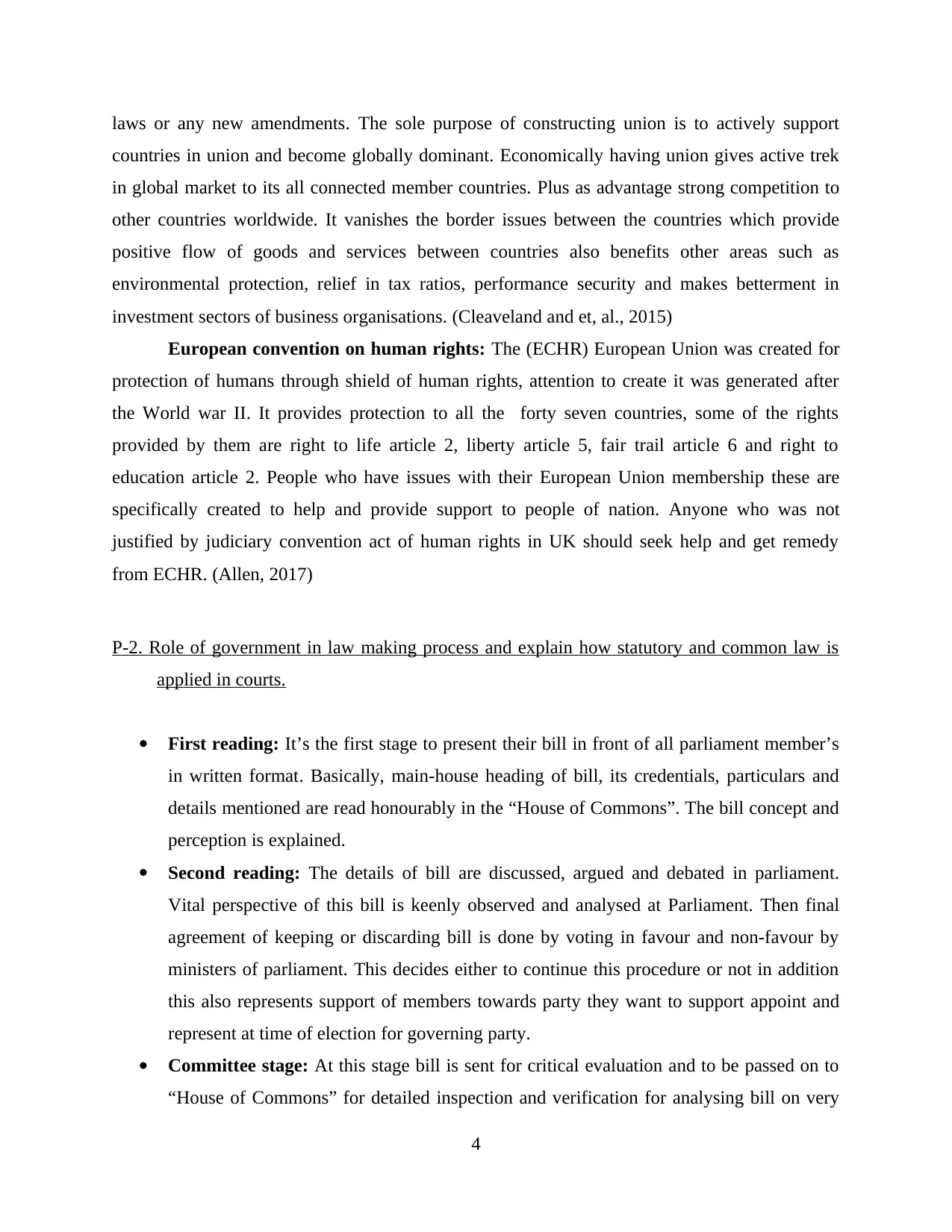
laws or any new amendments. The sole purpose of constructing union is to actively support
countries in union and become globally dominant. Economically having union gives active trek
in global market to its all connected member countries. Plus as advantage strong competition to
other countries worldwide. It vanishes the border issues between the countries which provide
positive flow of goods and services between countries also benefits other areas such as
environmental protection, relief in tax ratios, performance security and makes betterment in
investment sectors of business organisations. (Cleaveland and et, al., 2015)
European convention on human rights: The (ECHR) European Union was created for
protection of humans through shield of human rights, attention to create it was generated after
the World war II. It provides protection to all the forty seven countries, some of the rights
provided by them are right to life article 2, liberty article 5, fair trail article 6 and right to
education article 2. People who have issues with their European Union membership these are
specifically created to help and provide support to people of nation. Anyone who was not
justified by judiciary convention act of human rights in UK should seek help and get remedy
from ECHR. (Allen, 2017)
P-2. Role of government in law making process and explain how statutory and common law is
applied in courts.
First reading: It’s the first stage to present their bill in front of all parliament member’s
in written format. Basically, main-house heading of bill, its credentials, particulars and
details mentioned are read honourably in the “House of Commons”. The bill concept and
perception is explained.
Second reading: The details of bill are discussed, argued and debated in parliament.
Vital perspective of this bill is keenly observed and analysed at Parliament. Then final
agreement of keeping or discarding bill is done by voting in favour and non-favour by
ministers of parliament. This decides either to continue this procedure or not in addition
this also represents support of members towards party they want to support appoint and
represent at time of election for governing party.
Committee stage: At this stage bill is sent for critical evaluation and to be passed on to
“House of Commons” for detailed inspection and verification for analysing bill on very
4
countries in union and become globally dominant. Economically having union gives active trek
in global market to its all connected member countries. Plus as advantage strong competition to
other countries worldwide. It vanishes the border issues between the countries which provide
positive flow of goods and services between countries also benefits other areas such as
environmental protection, relief in tax ratios, performance security and makes betterment in
investment sectors of business organisations. (Cleaveland and et, al., 2015)
European convention on human rights: The (ECHR) European Union was created for
protection of humans through shield of human rights, attention to create it was generated after
the World war II. It provides protection to all the forty seven countries, some of the rights
provided by them are right to life article 2, liberty article 5, fair trail article 6 and right to
education article 2. People who have issues with their European Union membership these are
specifically created to help and provide support to people of nation. Anyone who was not
justified by judiciary convention act of human rights in UK should seek help and get remedy
from ECHR. (Allen, 2017)
P-2. Role of government in law making process and explain how statutory and common law is
applied in courts.
First reading: It’s the first stage to present their bill in front of all parliament member’s
in written format. Basically, main-house heading of bill, its credentials, particulars and
details mentioned are read honourably in the “House of Commons”. The bill concept and
perception is explained.
Second reading: The details of bill are discussed, argued and debated in parliament.
Vital perspective of this bill is keenly observed and analysed at Parliament. Then final
agreement of keeping or discarding bill is done by voting in favour and non-favour by
ministers of parliament. This decides either to continue this procedure or not in addition
this also represents support of members towards party they want to support appoint and
represent at time of election for governing party.
Committee stage: At this stage bill is sent for critical evaluation and to be passed on to
“House of Commons” for detailed inspection and verification for analysing bill on very
4
Paraphrase This Document
Need a fresh take? Get an instant paraphrase of this document with our AI Paraphraser
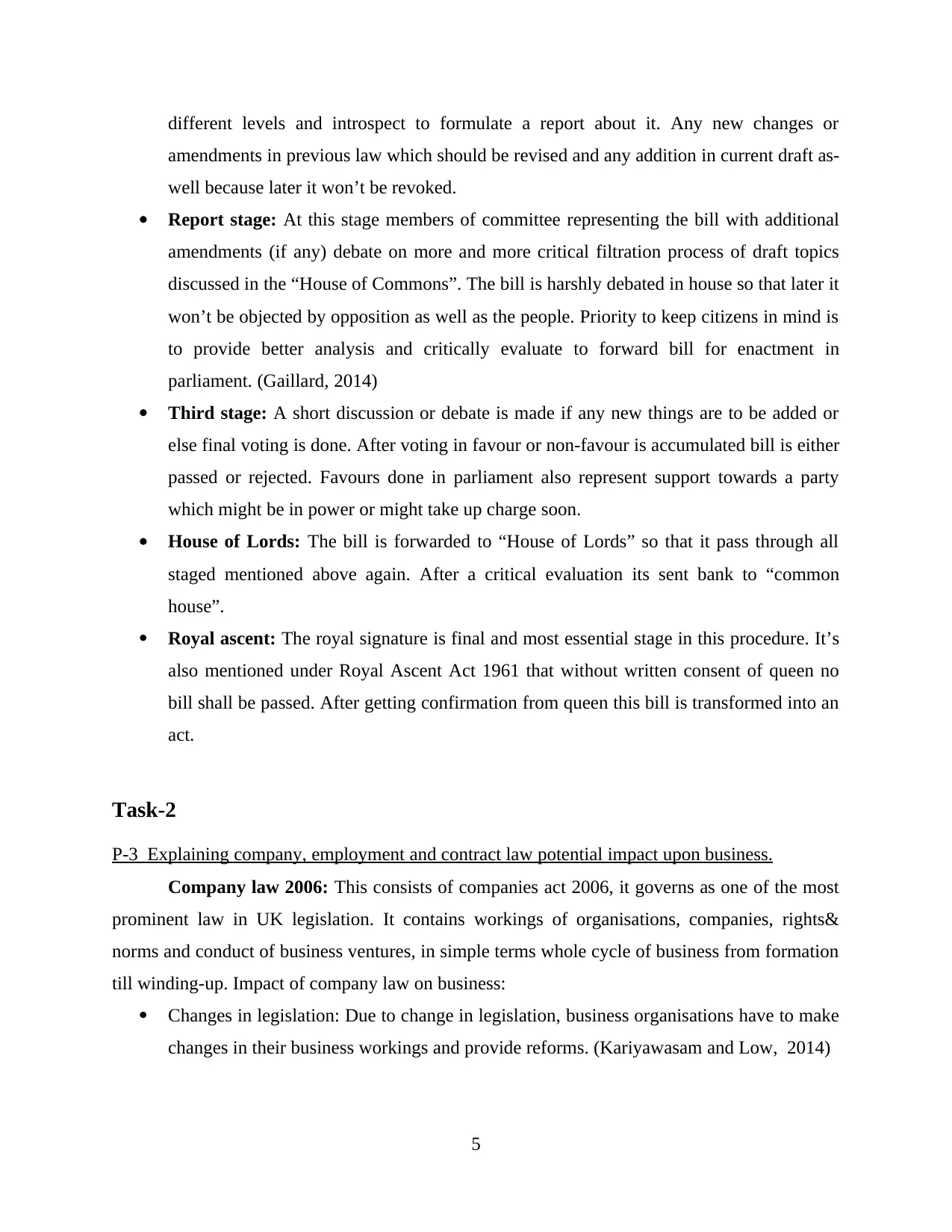
different levels and introspect to formulate a report about it. Any new changes or
amendments in previous law which should be revised and any addition in current draft as-
well because later it won’t be revoked.
Report stage: At this stage members of committee representing the bill with additional
amendments (if any) debate on more and more critical filtration process of draft topics
discussed in the “House of Commons”. The bill is harshly debated in house so that later it
won’t be objected by opposition as well as the people. Priority to keep citizens in mind is
to provide better analysis and critically evaluate to forward bill for enactment in
parliament. (Gaillard, 2014)
Third stage: A short discussion or debate is made if any new things are to be added or
else final voting is done. After voting in favour or non-favour is accumulated bill is either
passed or rejected. Favours done in parliament also represent support towards a party
which might be in power or might take up charge soon.
House of Lords: The bill is forwarded to “House of Lords” so that it pass through all
staged mentioned above again. After a critical evaluation its sent bank to “common
house”.
Royal ascent: The royal signature is final and most essential stage in this procedure. It’s
also mentioned under Royal Ascent Act 1961 that without written consent of queen no
bill shall be passed. After getting confirmation from queen this bill is transformed into an
act.
Task-2
P-3 Explaining company, employment and contract law potential impact upon business.
Company law 2006: This consists of companies act 2006, it governs as one of the most
prominent law in UK legislation. It contains workings of organisations, companies, rights&
norms and conduct of business ventures, in simple terms whole cycle of business from formation
till winding-up. Impact of company law on business:
Changes in legislation: Due to change in legislation, business organisations have to make
changes in their business workings and provide reforms. (Kariyawasam and Low, 2014)
5
amendments in previous law which should be revised and any addition in current draft as-
well because later it won’t be revoked.
Report stage: At this stage members of committee representing the bill with additional
amendments (if any) debate on more and more critical filtration process of draft topics
discussed in the “House of Commons”. The bill is harshly debated in house so that later it
won’t be objected by opposition as well as the people. Priority to keep citizens in mind is
to provide better analysis and critically evaluate to forward bill for enactment in
parliament. (Gaillard, 2014)
Third stage: A short discussion or debate is made if any new things are to be added or
else final voting is done. After voting in favour or non-favour is accumulated bill is either
passed or rejected. Favours done in parliament also represent support towards a party
which might be in power or might take up charge soon.
House of Lords: The bill is forwarded to “House of Lords” so that it pass through all
staged mentioned above again. After a critical evaluation its sent bank to “common
house”.
Royal ascent: The royal signature is final and most essential stage in this procedure. It’s
also mentioned under Royal Ascent Act 1961 that without written consent of queen no
bill shall be passed. After getting confirmation from queen this bill is transformed into an
act.
Task-2
P-3 Explaining company, employment and contract law potential impact upon business.
Company law 2006: This consists of companies act 2006, it governs as one of the most
prominent law in UK legislation. It contains workings of organisations, companies, rights&
norms and conduct of business ventures, in simple terms whole cycle of business from formation
till winding-up. Impact of company law on business:
Changes in legislation: Due to change in legislation, business organisations have to make
changes in their business workings and provide reforms. (Kariyawasam and Low, 2014)
5
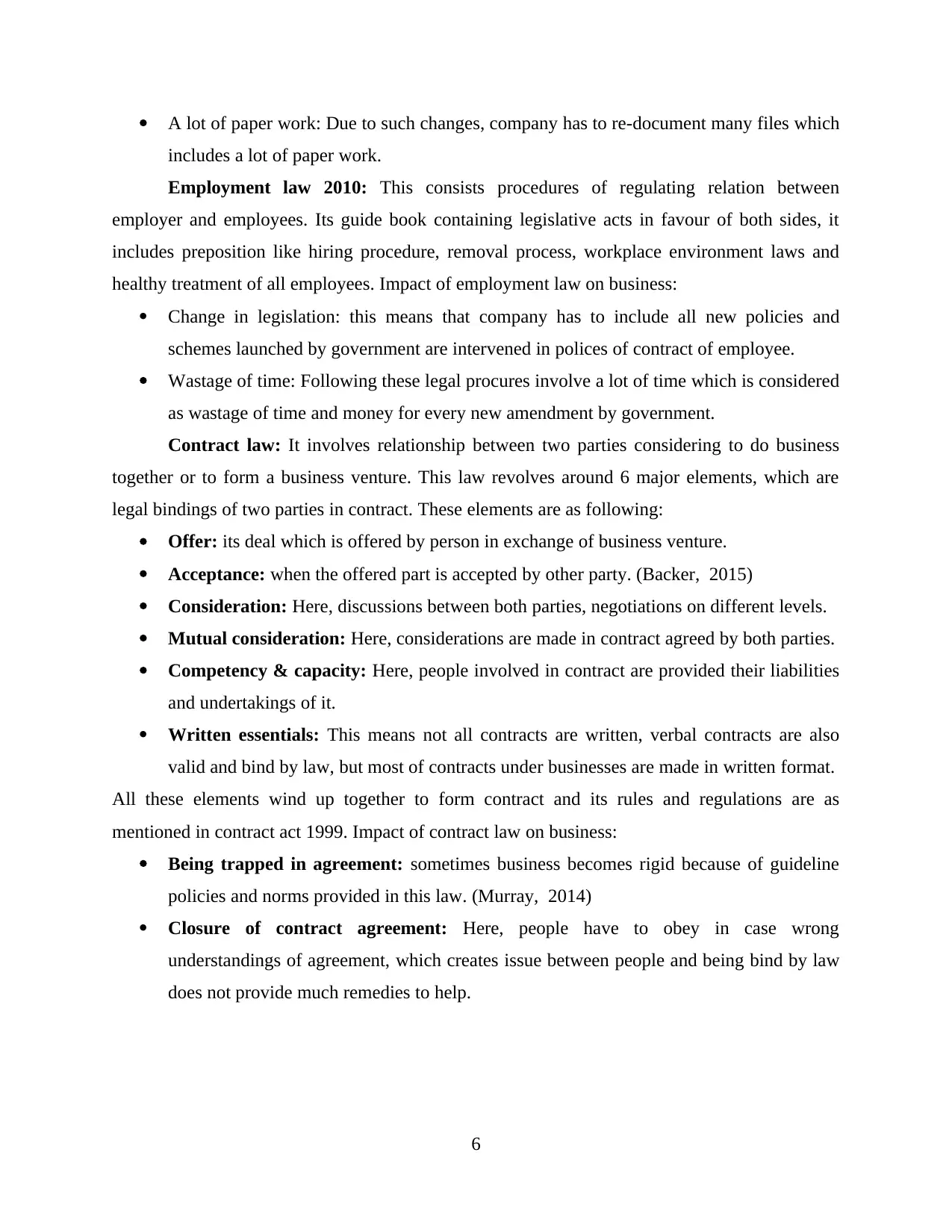
A lot of paper work: Due to such changes, company has to re-document many files which
includes a lot of paper work.
Employment law 2010: This consists procedures of regulating relation between
employer and employees. Its guide book containing legislative acts in favour of both sides, it
includes preposition like hiring procedure, removal process, workplace environment laws and
healthy treatment of all employees. Impact of employment law on business:
Change in legislation: this means that company has to include all new policies and
schemes launched by government are intervened in polices of contract of employee.
Wastage of time: Following these legal procures involve a lot of time which is considered
as wastage of time and money for every new amendment by government.
Contract law: It involves relationship between two parties considering to do business
together or to form a business venture. This law revolves around 6 major elements, which are
legal bindings of two parties in contract. These elements are as following:
Offer: its deal which is offered by person in exchange of business venture.
Acceptance: when the offered part is accepted by other party. (Backer, 2015)
Consideration: Here, discussions between both parties, negotiations on different levels.
Mutual consideration: Here, considerations are made in contract agreed by both parties.
Competency & capacity: Here, people involved in contract are provided their liabilities
and undertakings of it.
Written essentials: This means not all contracts are written, verbal contracts are also
valid and bind by law, but most of contracts under businesses are made in written format.
All these elements wind up together to form contract and its rules and regulations are as
mentioned in contract act 1999. Impact of contract law on business:
Being trapped in agreement: sometimes business becomes rigid because of guideline
policies and norms provided in this law. (Murray, 2014)
Closure of contract agreement: Here, people have to obey in case wrong
understandings of agreement, which creates issue between people and being bind by law
does not provide much remedies to help.
6
includes a lot of paper work.
Employment law 2010: This consists procedures of regulating relation between
employer and employees. Its guide book containing legislative acts in favour of both sides, it
includes preposition like hiring procedure, removal process, workplace environment laws and
healthy treatment of all employees. Impact of employment law on business:
Change in legislation: this means that company has to include all new policies and
schemes launched by government are intervened in polices of contract of employee.
Wastage of time: Following these legal procures involve a lot of time which is considered
as wastage of time and money for every new amendment by government.
Contract law: It involves relationship between two parties considering to do business
together or to form a business venture. This law revolves around 6 major elements, which are
legal bindings of two parties in contract. These elements are as following:
Offer: its deal which is offered by person in exchange of business venture.
Acceptance: when the offered part is accepted by other party. (Backer, 2015)
Consideration: Here, discussions between both parties, negotiations on different levels.
Mutual consideration: Here, considerations are made in contract agreed by both parties.
Competency & capacity: Here, people involved in contract are provided their liabilities
and undertakings of it.
Written essentials: This means not all contracts are written, verbal contracts are also
valid and bind by law, but most of contracts under businesses are made in written format.
All these elements wind up together to form contract and its rules and regulations are as
mentioned in contract act 1999. Impact of contract law on business:
Being trapped in agreement: sometimes business becomes rigid because of guideline
policies and norms provided in this law. (Murray, 2014)
Closure of contract agreement: Here, people have to obey in case wrong
understandings of agreement, which creates issue between people and being bind by law
does not provide much remedies to help.
6
⊘ This is a preview!⊘
Do you want full access?
Subscribe today to unlock all pages.

Trusted by 1+ million students worldwide
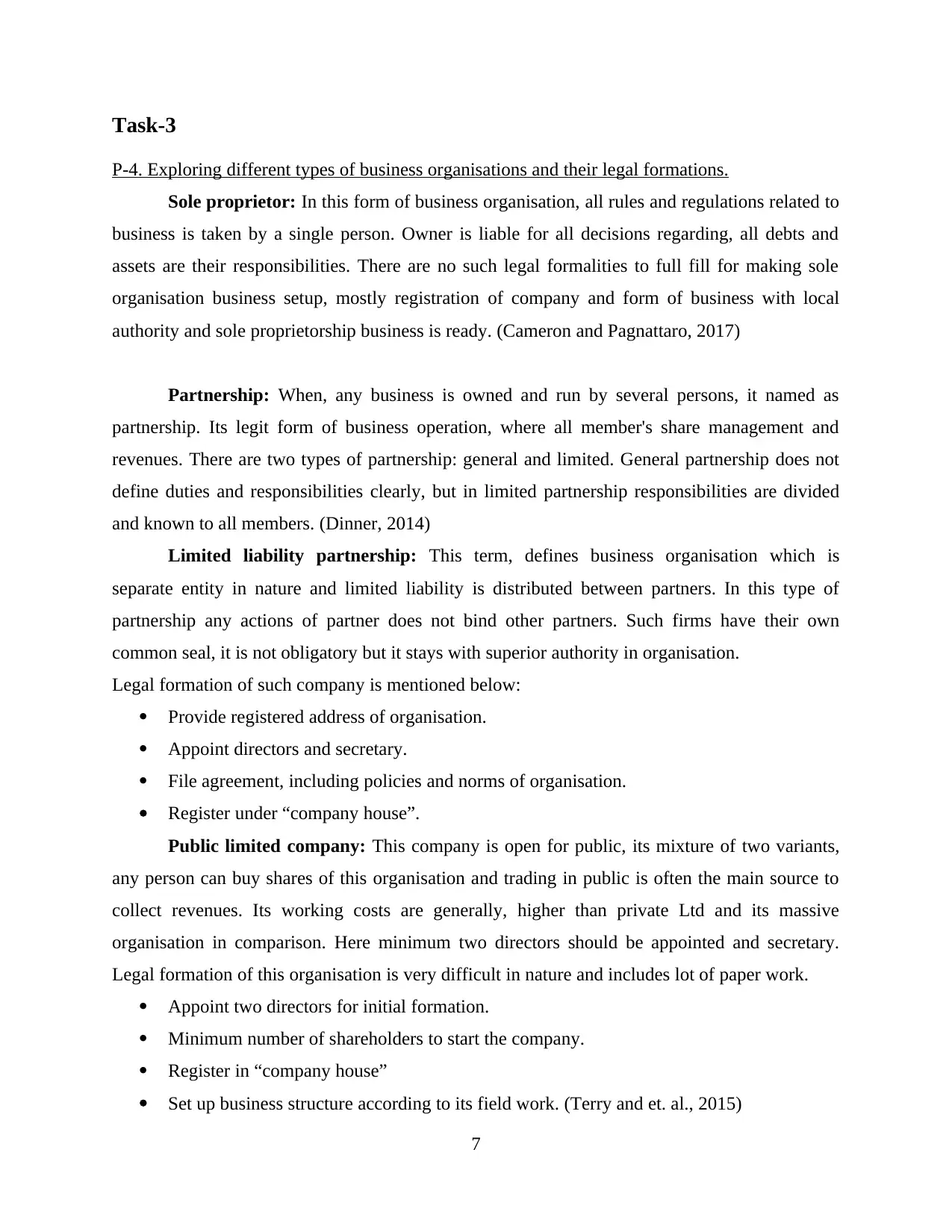
Task-3
P-4. Exploring different types of business organisations and their legal formations.
Sole proprietor: In this form of business organisation, all rules and regulations related to
business is taken by a single person. Owner is liable for all decisions regarding, all debts and
assets are their responsibilities. There are no such legal formalities to full fill for making sole
organisation business setup, mostly registration of company and form of business with local
authority and sole proprietorship business is ready. (Cameron and Pagnattaro, 2017)
Partnership: When, any business is owned and run by several persons, it named as
partnership. Its legit form of business operation, where all member's share management and
revenues. There are two types of partnership: general and limited. General partnership does not
define duties and responsibilities clearly, but in limited partnership responsibilities are divided
and known to all members. (Dinner, 2014)
Limited liability partnership: This term, defines business organisation which is
separate entity in nature and limited liability is distributed between partners. In this type of
partnership any actions of partner does not bind other partners. Such firms have their own
common seal, it is not obligatory but it stays with superior authority in organisation.
Legal formation of such company is mentioned below:
Provide registered address of organisation.
Appoint directors and secretary.
File agreement, including policies and norms of organisation.
Register under “company house”.
Public limited company: This company is open for public, its mixture of two variants,
any person can buy shares of this organisation and trading in public is often the main source to
collect revenues. Its working costs are generally, higher than private Ltd and its massive
organisation in comparison. Here minimum two directors should be appointed and secretary.
Legal formation of this organisation is very difficult in nature and includes lot of paper work.
Appoint two directors for initial formation.
Minimum number of shareholders to start the company.
Register in “company house”
Set up business structure according to its field work. (Terry and et. al., 2015)
7
P-4. Exploring different types of business organisations and their legal formations.
Sole proprietor: In this form of business organisation, all rules and regulations related to
business is taken by a single person. Owner is liable for all decisions regarding, all debts and
assets are their responsibilities. There are no such legal formalities to full fill for making sole
organisation business setup, mostly registration of company and form of business with local
authority and sole proprietorship business is ready. (Cameron and Pagnattaro, 2017)
Partnership: When, any business is owned and run by several persons, it named as
partnership. Its legit form of business operation, where all member's share management and
revenues. There are two types of partnership: general and limited. General partnership does not
define duties and responsibilities clearly, but in limited partnership responsibilities are divided
and known to all members. (Dinner, 2014)
Limited liability partnership: This term, defines business organisation which is
separate entity in nature and limited liability is distributed between partners. In this type of
partnership any actions of partner does not bind other partners. Such firms have their own
common seal, it is not obligatory but it stays with superior authority in organisation.
Legal formation of such company is mentioned below:
Provide registered address of organisation.
Appoint directors and secretary.
File agreement, including policies and norms of organisation.
Register under “company house”.
Public limited company: This company is open for public, its mixture of two variants,
any person can buy shares of this organisation and trading in public is often the main source to
collect revenues. Its working costs are generally, higher than private Ltd and its massive
organisation in comparison. Here minimum two directors should be appointed and secretary.
Legal formation of this organisation is very difficult in nature and includes lot of paper work.
Appoint two directors for initial formation.
Minimum number of shareholders to start the company.
Register in “company house”
Set up business structure according to its field work. (Terry and et. al., 2015)
7
Paraphrase This Document
Need a fresh take? Get an instant paraphrase of this document with our AI Paraphraser
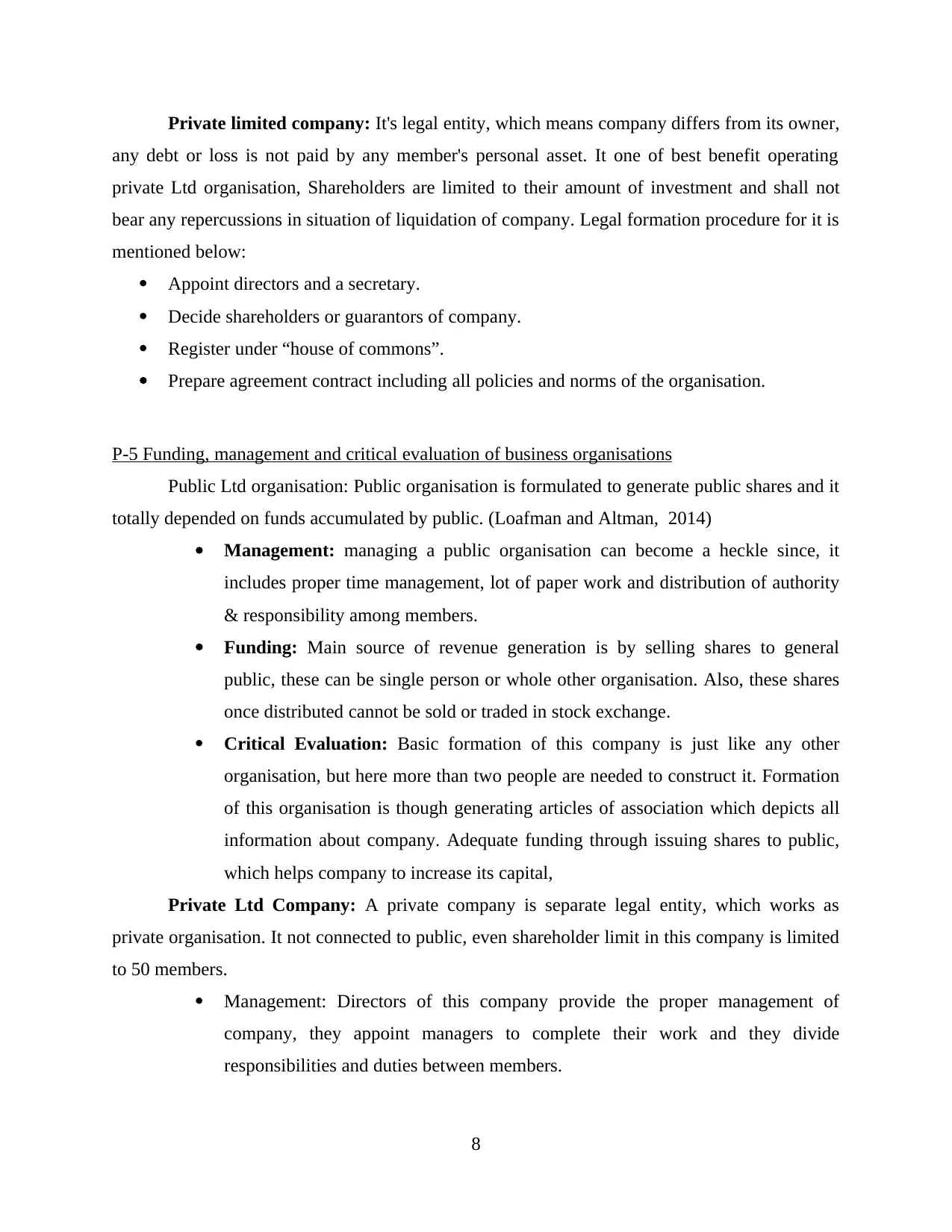
Private limited company: It's legal entity, which means company differs from its owner,
any debt or loss is not paid by any member's personal asset. It one of best benefit operating
private Ltd organisation, Shareholders are limited to their amount of investment and shall not
bear any repercussions in situation of liquidation of company. Legal formation procedure for it is
mentioned below:
Appoint directors and a secretary.
Decide shareholders or guarantors of company.
Register under “house of commons”.
Prepare agreement contract including all policies and norms of the organisation.
P-5 Funding, management and critical evaluation of business organisations
Public Ltd organisation: Public organisation is formulated to generate public shares and it
totally depended on funds accumulated by public. (Loafman and Altman, 2014)
Management: managing a public organisation can become a heckle since, it
includes proper time management, lot of paper work and distribution of authority
& responsibility among members.
Funding: Main source of revenue generation is by selling shares to general
public, these can be single person or whole other organisation. Also, these shares
once distributed cannot be sold or traded in stock exchange.
Critical Evaluation: Basic formation of this company is just like any other
organisation, but here more than two people are needed to construct it. Formation
of this organisation is though generating articles of association which depicts all
information about company. Adequate funding through issuing shares to public,
which helps company to increase its capital,
Private Ltd Company: A private company is separate legal entity, which works as
private organisation. It not connected to public, even shareholder limit in this company is limited
to 50 members.
Management: Directors of this company provide the proper management of
company, they appoint managers to complete their work and they divide
responsibilities and duties between members.
8
any debt or loss is not paid by any member's personal asset. It one of best benefit operating
private Ltd organisation, Shareholders are limited to their amount of investment and shall not
bear any repercussions in situation of liquidation of company. Legal formation procedure for it is
mentioned below:
Appoint directors and a secretary.
Decide shareholders or guarantors of company.
Register under “house of commons”.
Prepare agreement contract including all policies and norms of the organisation.
P-5 Funding, management and critical evaluation of business organisations
Public Ltd organisation: Public organisation is formulated to generate public shares and it
totally depended on funds accumulated by public. (Loafman and Altman, 2014)
Management: managing a public organisation can become a heckle since, it
includes proper time management, lot of paper work and distribution of authority
& responsibility among members.
Funding: Main source of revenue generation is by selling shares to general
public, these can be single person or whole other organisation. Also, these shares
once distributed cannot be sold or traded in stock exchange.
Critical Evaluation: Basic formation of this company is just like any other
organisation, but here more than two people are needed to construct it. Formation
of this organisation is though generating articles of association which depicts all
information about company. Adequate funding through issuing shares to public,
which helps company to increase its capital,
Private Ltd Company: A private company is separate legal entity, which works as
private organisation. It not connected to public, even shareholder limit in this company is limited
to 50 members.
Management: Directors of this company provide the proper management of
company, they appoint managers to complete their work and they divide
responsibilities and duties between members.
8
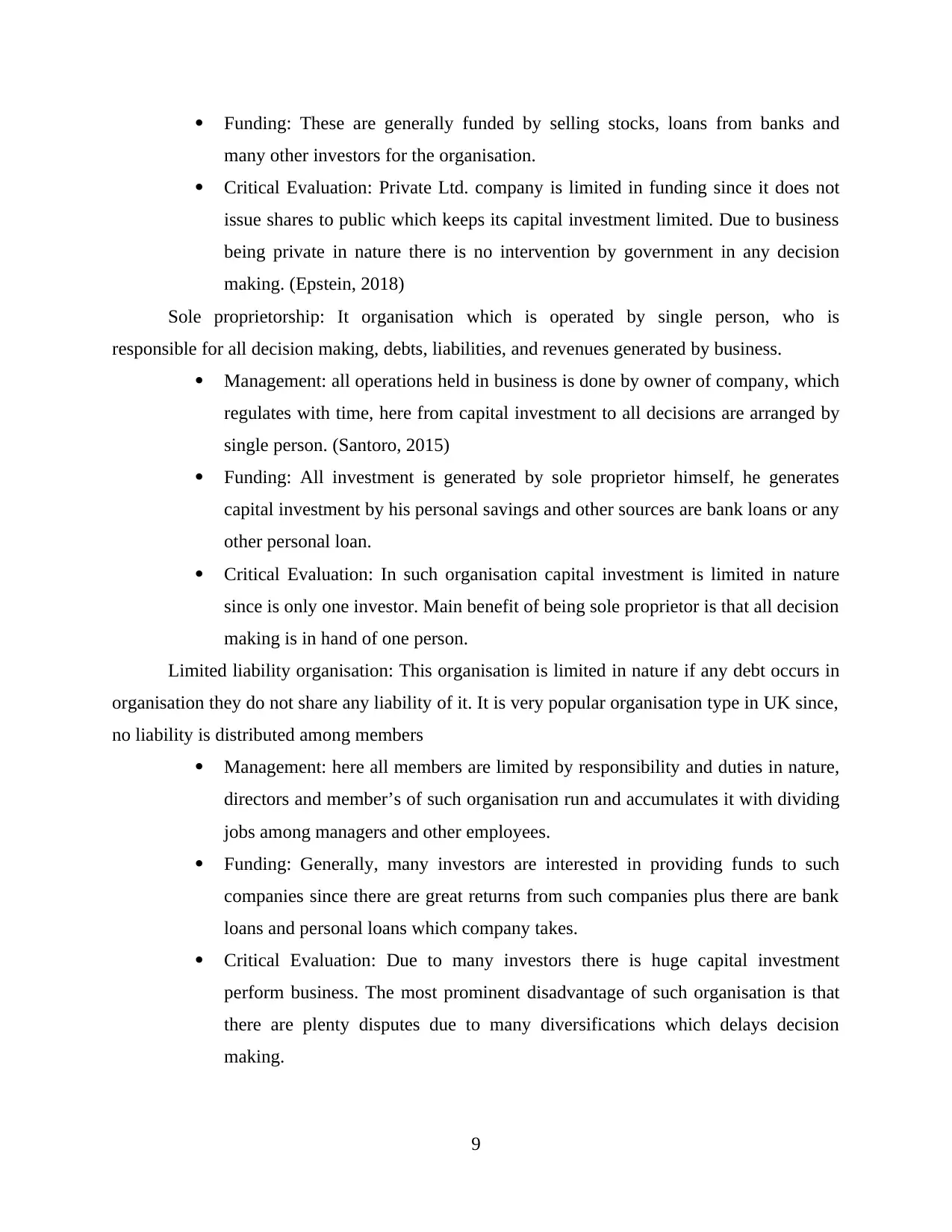
Funding: These are generally funded by selling stocks, loans from banks and
many other investors for the organisation.
Critical Evaluation: Private Ltd. company is limited in funding since it does not
issue shares to public which keeps its capital investment limited. Due to business
being private in nature there is no intervention by government in any decision
making. (Epstein, 2018)
Sole proprietorship: It organisation which is operated by single person, who is
responsible for all decision making, debts, liabilities, and revenues generated by business.
Management: all operations held in business is done by owner of company, which
regulates with time, here from capital investment to all decisions are arranged by
single person. (Santoro, 2015)
Funding: All investment is generated by sole proprietor himself, he generates
capital investment by his personal savings and other sources are bank loans or any
other personal loan.
Critical Evaluation: In such organisation capital investment is limited in nature
since is only one investor. Main benefit of being sole proprietor is that all decision
making is in hand of one person.
Limited liability organisation: This organisation is limited in nature if any debt occurs in
organisation they do not share any liability of it. It is very popular organisation type in UK since,
no liability is distributed among members
Management: here all members are limited by responsibility and duties in nature,
directors and member’s of such organisation run and accumulates it with dividing
jobs among managers and other employees.
Funding: Generally, many investors are interested in providing funds to such
companies since there are great returns from such companies plus there are bank
loans and personal loans which company takes.
Critical Evaluation: Due to many investors there is huge capital investment
perform business. The most prominent disadvantage of such organisation is that
there are plenty disputes due to many diversifications which delays decision
making.
9
many other investors for the organisation.
Critical Evaluation: Private Ltd. company is limited in funding since it does not
issue shares to public which keeps its capital investment limited. Due to business
being private in nature there is no intervention by government in any decision
making. (Epstein, 2018)
Sole proprietorship: It organisation which is operated by single person, who is
responsible for all decision making, debts, liabilities, and revenues generated by business.
Management: all operations held in business is done by owner of company, which
regulates with time, here from capital investment to all decisions are arranged by
single person. (Santoro, 2015)
Funding: All investment is generated by sole proprietor himself, he generates
capital investment by his personal savings and other sources are bank loans or any
other personal loan.
Critical Evaluation: In such organisation capital investment is limited in nature
since is only one investor. Main benefit of being sole proprietor is that all decision
making is in hand of one person.
Limited liability organisation: This organisation is limited in nature if any debt occurs in
organisation they do not share any liability of it. It is very popular organisation type in UK since,
no liability is distributed among members
Management: here all members are limited by responsibility and duties in nature,
directors and member’s of such organisation run and accumulates it with dividing
jobs among managers and other employees.
Funding: Generally, many investors are interested in providing funds to such
companies since there are great returns from such companies plus there are bank
loans and personal loans which company takes.
Critical Evaluation: Due to many investors there is huge capital investment
perform business. The most prominent disadvantage of such organisation is that
there are plenty disputes due to many diversifications which delays decision
making.
9
⊘ This is a preview!⊘
Do you want full access?
Subscribe today to unlock all pages.

Trusted by 1+ million students worldwide
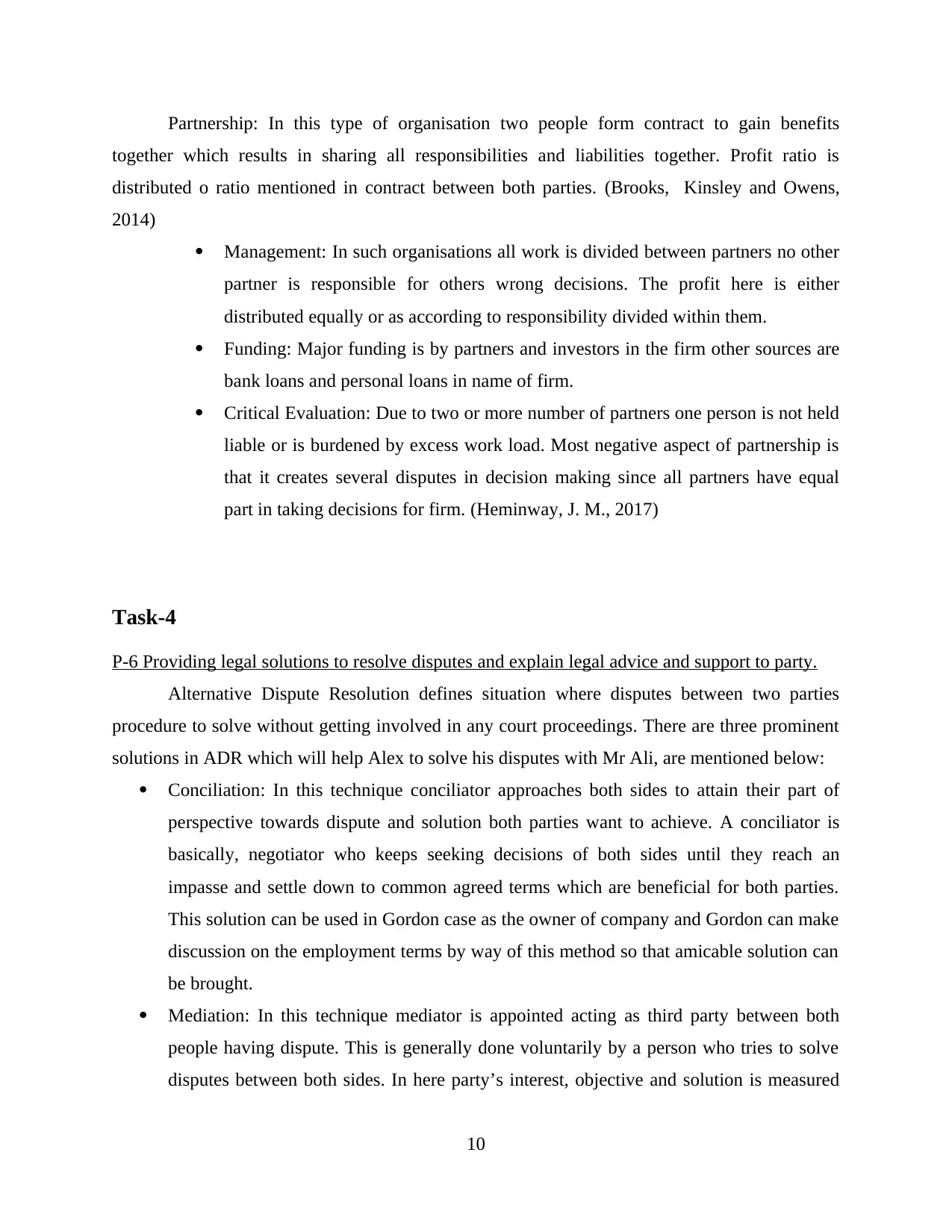
Partnership: In this type of organisation two people form contract to gain benefits
together which results in sharing all responsibilities and liabilities together. Profit ratio is
distributed o ratio mentioned in contract between both parties. (Brooks, Kinsley and Owens,
2014)
Management: In such organisations all work is divided between partners no other
partner is responsible for others wrong decisions. The profit here is either
distributed equally or as according to responsibility divided within them.
Funding: Major funding is by partners and investors in the firm other sources are
bank loans and personal loans in name of firm.
Critical Evaluation: Due to two or more number of partners one person is not held
liable or is burdened by excess work load. Most negative aspect of partnership is
that it creates several disputes in decision making since all partners have equal
part in taking decisions for firm. (Heminway, J. M., 2017)
Task-4
P-6 Providing legal solutions to resolve disputes and explain legal advice and support to party.
Alternative Dispute Resolution defines situation where disputes between two parties
procedure to solve without getting involved in any court proceedings. There are three prominent
solutions in ADR which will help Alex to solve his disputes with Mr Ali, are mentioned below:
Conciliation: In this technique conciliator approaches both sides to attain their part of
perspective towards dispute and solution both parties want to achieve. A conciliator is
basically, negotiator who keeps seeking decisions of both sides until they reach an
impasse and settle down to common agreed terms which are beneficial for both parties.
This solution can be used in Gordon case as the owner of company and Gordon can make
discussion on the employment terms by way of this method so that amicable solution can
be brought.
Mediation: In this technique mediator is appointed acting as third party between both
people having dispute. This is generally done voluntarily by a person who tries to solve
disputes between both sides. In here party’s interest, objective and solution is measured
10
together which results in sharing all responsibilities and liabilities together. Profit ratio is
distributed o ratio mentioned in contract between both parties. (Brooks, Kinsley and Owens,
2014)
Management: In such organisations all work is divided between partners no other
partner is responsible for others wrong decisions. The profit here is either
distributed equally or as according to responsibility divided within them.
Funding: Major funding is by partners and investors in the firm other sources are
bank loans and personal loans in name of firm.
Critical Evaluation: Due to two or more number of partners one person is not held
liable or is burdened by excess work load. Most negative aspect of partnership is
that it creates several disputes in decision making since all partners have equal
part in taking decisions for firm. (Heminway, J. M., 2017)
Task-4
P-6 Providing legal solutions to resolve disputes and explain legal advice and support to party.
Alternative Dispute Resolution defines situation where disputes between two parties
procedure to solve without getting involved in any court proceedings. There are three prominent
solutions in ADR which will help Alex to solve his disputes with Mr Ali, are mentioned below:
Conciliation: In this technique conciliator approaches both sides to attain their part of
perspective towards dispute and solution both parties want to achieve. A conciliator is
basically, negotiator who keeps seeking decisions of both sides until they reach an
impasse and settle down to common agreed terms which are beneficial for both parties.
This solution can be used in Gordon case as the owner of company and Gordon can make
discussion on the employment terms by way of this method so that amicable solution can
be brought.
Mediation: In this technique mediator is appointed acting as third party between both
people having dispute. This is generally done voluntarily by a person who tries to solve
disputes between both sides. In here party’s interest, objective and solution is measured
10
Paraphrase This Document
Need a fresh take? Get an instant paraphrase of this document with our AI Paraphraser
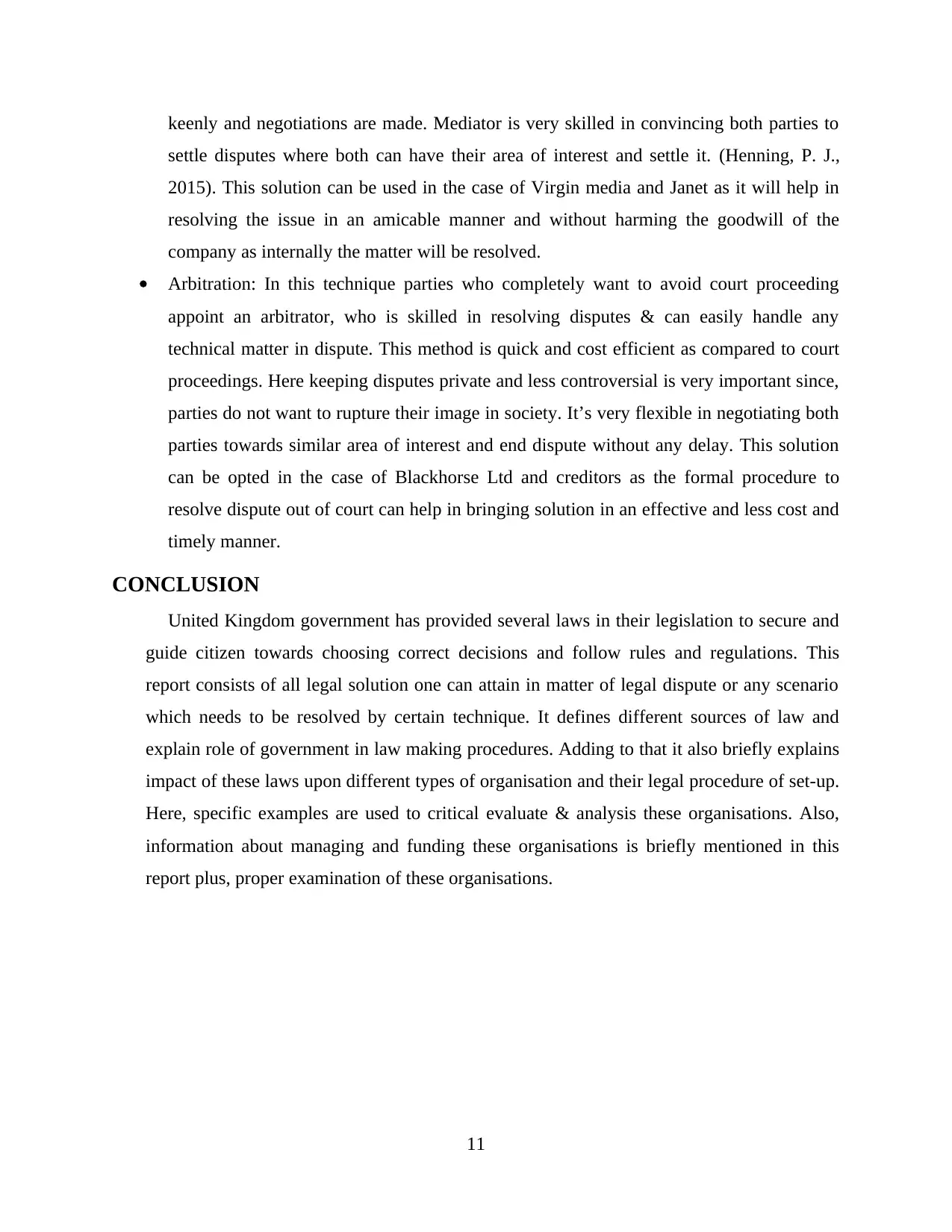
keenly and negotiations are made. Mediator is very skilled in convincing both parties to
settle disputes where both can have their area of interest and settle it. (Henning, P. J.,
2015). This solution can be used in the case of Virgin media and Janet as it will help in
resolving the issue in an amicable manner and without harming the goodwill of the
company as internally the matter will be resolved.
Arbitration: In this technique parties who completely want to avoid court proceeding
appoint an arbitrator, who is skilled in resolving disputes & can easily handle any
technical matter in dispute. This method is quick and cost efficient as compared to court
proceedings. Here keeping disputes private and less controversial is very important since,
parties do not want to rupture their image in society. It’s very flexible in negotiating both
parties towards similar area of interest and end dispute without any delay. This solution
can be opted in the case of Blackhorse Ltd and creditors as the formal procedure to
resolve dispute out of court can help in bringing solution in an effective and less cost and
timely manner.
CONCLUSION
United Kingdom government has provided several laws in their legislation to secure and
guide citizen towards choosing correct decisions and follow rules and regulations. This
report consists of all legal solution one can attain in matter of legal dispute or any scenario
which needs to be resolved by certain technique. It defines different sources of law and
explain role of government in law making procedures. Adding to that it also briefly explains
impact of these laws upon different types of organisation and their legal procedure of set-up.
Here, specific examples are used to critical evaluate & analysis these organisations. Also,
information about managing and funding these organisations is briefly mentioned in this
report plus, proper examination of these organisations.
11
settle disputes where both can have their area of interest and settle it. (Henning, P. J.,
2015). This solution can be used in the case of Virgin media and Janet as it will help in
resolving the issue in an amicable manner and without harming the goodwill of the
company as internally the matter will be resolved.
Arbitration: In this technique parties who completely want to avoid court proceeding
appoint an arbitrator, who is skilled in resolving disputes & can easily handle any
technical matter in dispute. This method is quick and cost efficient as compared to court
proceedings. Here keeping disputes private and less controversial is very important since,
parties do not want to rupture their image in society. It’s very flexible in negotiating both
parties towards similar area of interest and end dispute without any delay. This solution
can be opted in the case of Blackhorse Ltd and creditors as the formal procedure to
resolve dispute out of court can help in bringing solution in an effective and less cost and
timely manner.
CONCLUSION
United Kingdom government has provided several laws in their legislation to secure and
guide citizen towards choosing correct decisions and follow rules and regulations. This
report consists of all legal solution one can attain in matter of legal dispute or any scenario
which needs to be resolved by certain technique. It defines different sources of law and
explain role of government in law making procedures. Adding to that it also briefly explains
impact of these laws upon different types of organisation and their legal procedure of set-up.
Here, specific examples are used to critical evaluate & analysis these organisations. Also,
information about managing and funding these organisations is briefly mentioned in this
report plus, proper examination of these organisations.
11
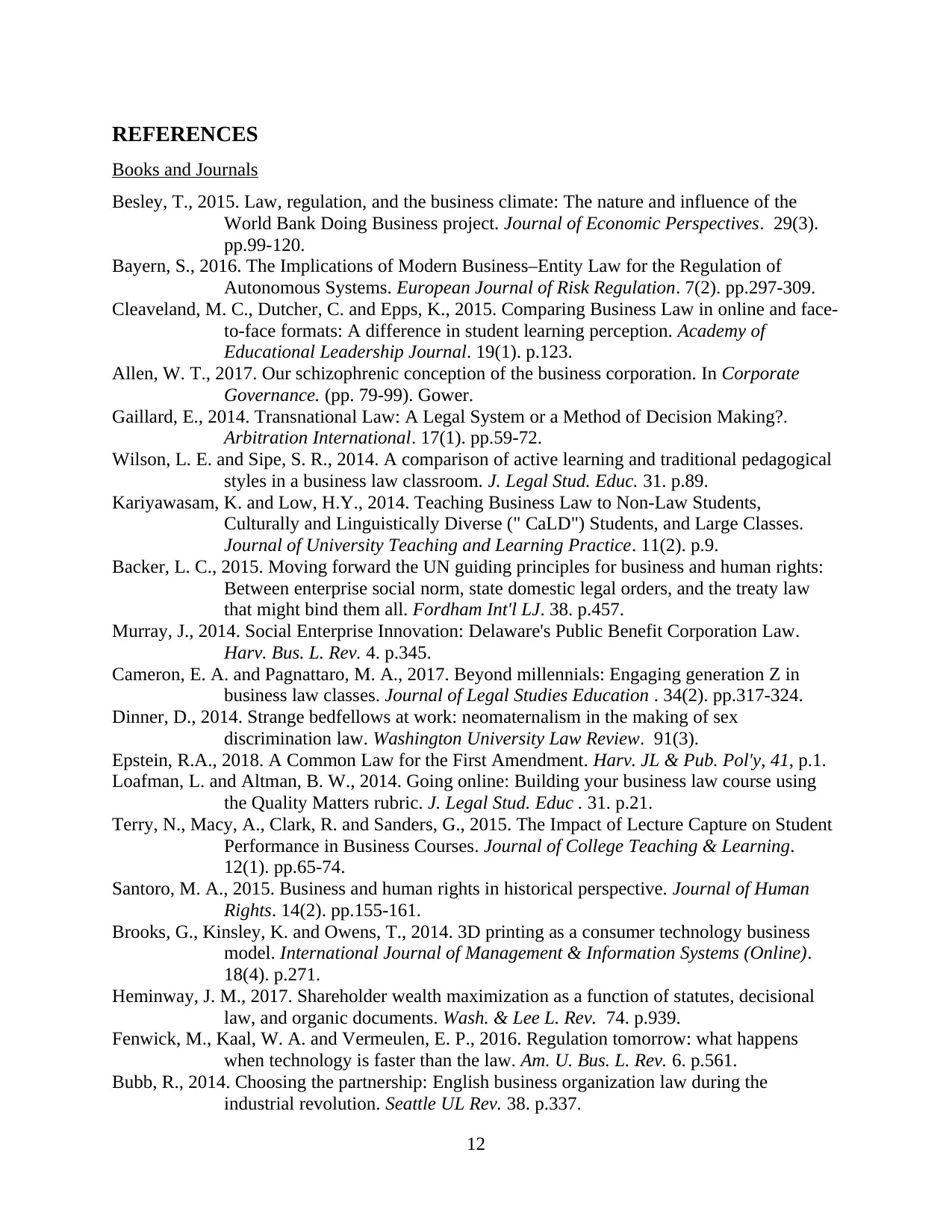
REFERENCES
Books and Journals
Besley, T., 2015. Law, regulation, and the business climate: The nature and influence of the
World Bank Doing Business project. Journal of Economic Perspectives. 29(3).
pp.99-120.
Bayern, S., 2016. The Implications of Modern Business–Entity Law for the Regulation of
Autonomous Systems. European Journal of Risk Regulation. 7(2). pp.297-309.
Cleaveland, M. C., Dutcher, C. and Epps, K., 2015. Comparing Business Law in online and face-
to-face formats: A difference in student learning perception. Academy of
Educational Leadership Journal. 19(1). p.123.
Allen, W. T., 2017. Our schizophrenic conception of the business corporation. In Corporate
Governance. (pp. 79-99). Gower.
Gaillard, E., 2014. Transnational Law: A Legal System or a Method of Decision Making?.
Arbitration International. 17(1). pp.59-72.
Wilson, L. E. and Sipe, S. R., 2014. A comparison of active learning and traditional pedagogical
styles in a business law classroom. J. Legal Stud. Educ. 31. p.89.
Kariyawasam, K. and Low, H.Y., 2014. Teaching Business Law to Non-Law Students,
Culturally and Linguistically Diverse (" CaLD") Students, and Large Classes.
Journal of University Teaching and Learning Practice. 11(2). p.9.
Backer, L. C., 2015. Moving forward the UN guiding principles for business and human rights:
Between enterprise social norm, state domestic legal orders, and the treaty law
that might bind them all. Fordham Int'l LJ. 38. p.457.
Murray, J., 2014. Social Enterprise Innovation: Delaware's Public Benefit Corporation Law.
Harv. Bus. L. Rev. 4. p.345.
Cameron, E. A. and Pagnattaro, M. A., 2017. Beyond millennials: Engaging generation Z in
business law classes. Journal of Legal Studies Education . 34(2). pp.317-324.
Dinner, D., 2014. Strange bedfellows at work: neomaternalism in the making of sex
discrimination law. Washington University Law Review. 91(3).
Epstein, R.A., 2018. A Common Law for the First Amendment. Harv. JL & Pub. Pol'y, 41, p.1.
Loafman, L. and Altman, B. W., 2014. Going online: Building your business law course using
the Quality Matters rubric. J. Legal Stud. Educ . 31. p.21.
Terry, N., Macy, A., Clark, R. and Sanders, G., 2015. The Impact of Lecture Capture on Student
Performance in Business Courses. Journal of College Teaching & Learning.
12(1). pp.65-74.
Santoro, M. A., 2015. Business and human rights in historical perspective. Journal of Human
Rights. 14(2). pp.155-161.
Brooks, G., Kinsley, K. and Owens, T., 2014. 3D printing as a consumer technology business
model. International Journal of Management & Information Systems (Online).
18(4). p.271.
Heminway, J. M., 2017. Shareholder wealth maximization as a function of statutes, decisional
law, and organic documents. Wash. & Lee L. Rev. 74. p.939.
Fenwick, M., Kaal, W. A. and Vermeulen, E. P., 2016. Regulation tomorrow: what happens
when technology is faster than the law. Am. U. Bus. L. Rev. 6. p.561.
Bubb, R., 2014. Choosing the partnership: English business organization law during the
industrial revolution. Seattle UL Rev. 38. p.337.
12
Books and Journals
Besley, T., 2015. Law, regulation, and the business climate: The nature and influence of the
World Bank Doing Business project. Journal of Economic Perspectives. 29(3).
pp.99-120.
Bayern, S., 2016. The Implications of Modern Business–Entity Law for the Regulation of
Autonomous Systems. European Journal of Risk Regulation. 7(2). pp.297-309.
Cleaveland, M. C., Dutcher, C. and Epps, K., 2015. Comparing Business Law in online and face-
to-face formats: A difference in student learning perception. Academy of
Educational Leadership Journal. 19(1). p.123.
Allen, W. T., 2017. Our schizophrenic conception of the business corporation. In Corporate
Governance. (pp. 79-99). Gower.
Gaillard, E., 2014. Transnational Law: A Legal System or a Method of Decision Making?.
Arbitration International. 17(1). pp.59-72.
Wilson, L. E. and Sipe, S. R., 2014. A comparison of active learning and traditional pedagogical
styles in a business law classroom. J. Legal Stud. Educ. 31. p.89.
Kariyawasam, K. and Low, H.Y., 2014. Teaching Business Law to Non-Law Students,
Culturally and Linguistically Diverse (" CaLD") Students, and Large Classes.
Journal of University Teaching and Learning Practice. 11(2). p.9.
Backer, L. C., 2015. Moving forward the UN guiding principles for business and human rights:
Between enterprise social norm, state domestic legal orders, and the treaty law
that might bind them all. Fordham Int'l LJ. 38. p.457.
Murray, J., 2014. Social Enterprise Innovation: Delaware's Public Benefit Corporation Law.
Harv. Bus. L. Rev. 4. p.345.
Cameron, E. A. and Pagnattaro, M. A., 2017. Beyond millennials: Engaging generation Z in
business law classes. Journal of Legal Studies Education . 34(2). pp.317-324.
Dinner, D., 2014. Strange bedfellows at work: neomaternalism in the making of sex
discrimination law. Washington University Law Review. 91(3).
Epstein, R.A., 2018. A Common Law for the First Amendment. Harv. JL & Pub. Pol'y, 41, p.1.
Loafman, L. and Altman, B. W., 2014. Going online: Building your business law course using
the Quality Matters rubric. J. Legal Stud. Educ . 31. p.21.
Terry, N., Macy, A., Clark, R. and Sanders, G., 2015. The Impact of Lecture Capture on Student
Performance in Business Courses. Journal of College Teaching & Learning.
12(1). pp.65-74.
Santoro, M. A., 2015. Business and human rights in historical perspective. Journal of Human
Rights. 14(2). pp.155-161.
Brooks, G., Kinsley, K. and Owens, T., 2014. 3D printing as a consumer technology business
model. International Journal of Management & Information Systems (Online).
18(4). p.271.
Heminway, J. M., 2017. Shareholder wealth maximization as a function of statutes, decisional
law, and organic documents. Wash. & Lee L. Rev. 74. p.939.
Fenwick, M., Kaal, W. A. and Vermeulen, E. P., 2016. Regulation tomorrow: what happens
when technology is faster than the law. Am. U. Bus. L. Rev. 6. p.561.
Bubb, R., 2014. Choosing the partnership: English business organization law during the
industrial revolution. Seattle UL Rev. 38. p.337.
12
⊘ This is a preview!⊘
Do you want full access?
Subscribe today to unlock all pages.

Trusted by 1+ million students worldwide
1 out of 13
Related Documents
Your All-in-One AI-Powered Toolkit for Academic Success.
+13062052269
info@desklib.com
Available 24*7 on WhatsApp / Email
![[object Object]](/_next/static/media/star-bottom.7253800d.svg)
Unlock your academic potential
Copyright © 2020–2025 A2Z Services. All Rights Reserved. Developed and managed by ZUCOL.




